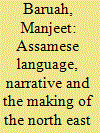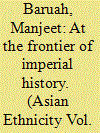|
|
|
Sort Order |
|
|
|
Items / Page
|
|
|
|
|
|
|
| Srl | Item |
| 1 |
ID:
118928


|
|
|
|
|
| Publication |
2013.
|
| Summary/Abstract |
This paper is divided into two broad sections. The first section deals with the Brahmaputra Valley in Assam (north east India) and its transformation into a frontier in the nineteenth century. The section also deals with how this process was closely linked to the re-interpretation of the region's relationship with Indo-Gangetic culture, and the impact on development of the modern 'Assamese' language. The second section interprets modern Assamese novels in the light of the issues raised in the first section. It explores how issues such as indigeneity, the concept of India and modern Assamese language, share a relation of conflict in modern Assamese fiction. It is suggested in the conclusion that, due to such historical specificities, the language and narrative of the frontier require a specific regional approach, and should not be subsumed within larger frameworks such as 'the nation' or 'South Asia'.
|
|
|
|
|
|
|
|
|
|
|
|
|
|
|
|
| 2 |
ID:
152997


|
|
|
|
|
| Summary/Abstract |
Edward Gait’s A History of Assam was first published in 1906, later revised in 1926. The book has remained one of the most popular ‘textbooks’ in Assam, especially as the first modern historiography on the subject. This article looks at two broad issues in this regard. First, it looks at the contradictions that Gait was faced with in terms of his imperial ideology and interpreting the historical sources of an imperial frontier. Second, it tries to situate the relevance of the above point vis-à-vis some of the contemporary attempts at re-framing the region as an international borderland. In conclusion, the article looks at the reception of Gait and his appropriation into different discourses within Assam. A point explored is whether despite its contradictions, was Gait’s A History of Assam part of a wider, dynamic context of early twentieth century Assam, which made the book an important academic and political intervention of its times.
|
|
|
|
|
|
|
|
|
|
|
|
|
|
|
|
| 3 |
ID:
181679


|
|
|
|
|
| Summary/Abstract |
Hunting encompasses a range of sensory experiences such as sight, smell and taste (game as food). On the tea frontier of British Assam, such a sensory world of hunting was closely connected to the ideas and practices of empire, as well as to the production of the global commodity of tea. In this regard, A.R. Ramsden’s memoir, Assam Planter: Tea Planting and Hunting in Assam (1945), provides a rich illustration of sensory experiences in the making of such a tea frontier and a global commodity. Furthermore, the memoir is constituted through the complex interplay of senses that is mapped onto the plantation social order. In the process, the sensory experiences of the ‘sahib’ and the ‘native’ are organised in an imperial narrative of tea and frontier-making. Yet, given its historical moment, the context of imperial crisis is also reflected in the memoir through the contradictions of sensory experiences and, thereby, the problems faced in producing the imperial narrative of tea and frontier-making.
|
|
|
|
|
|
|
|
|
|
|
|
|
|
|
|
|
|
|
|
|